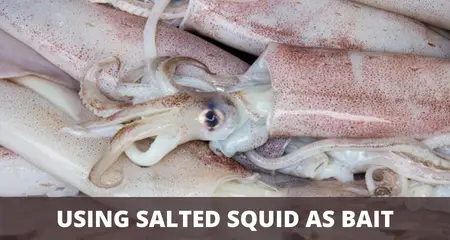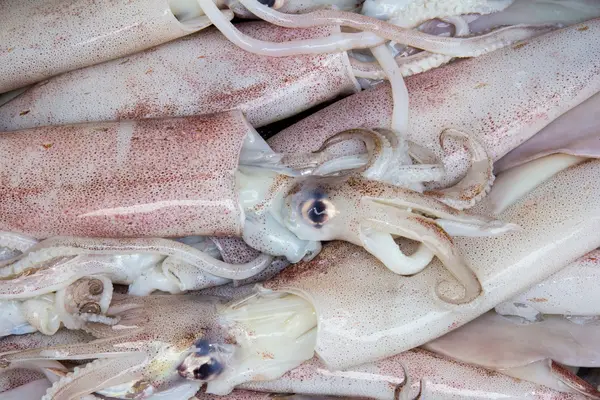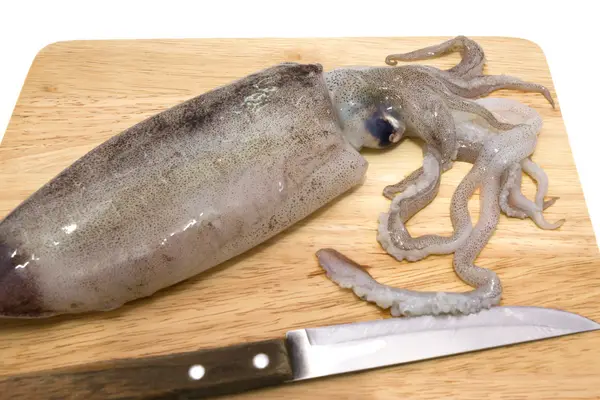Using Salted Squid As Bait (3 Tips To Catch More Fish)
UPDATED 03 NOVEMBER 2023
by Robert Ceran
Squid is one of the best baits for many saltwater fish. It’s not only effective, it’s also cheap, can be used fresh, salted or frozen, and you don’t have to keep it alive.
Plus, you can also combine squid strips with other baits to make even more appealing presentations that the fish just can’t resist.
In this article I’ll explain how to prepare and use salted squid bait, which in my opinion is the best squid bait available for saltwater fishing.

Salted squid vs frozen squid – which is better bait?
Fresh squid that has been preserved with salt will always out fish any frozen squid, period.
If fresh squid is salted quickly after purchase, it will retain a lot of its enticing oily aroma, texture, and smell.
Frozen squid, on the other hand, becomes soggy and bland during the freezing and thawing process.

And the great thing about salting fresh squid is that it is usually quite cheap, and you can easily prepare enough in one go to last you for a whole season.
A wide variety of fish species, from flounder to croaker and striped bass, love squid, and are readily caught on salted squid baits.
Even a passing cobia can be enticed to bite on a squid bait by using a beautiful long strip presented on a bucktail jig.
How to salt fresh squid yourself
Now let’s walk through the steps of salting fresh squid at home.
Start by buying squid that has not been frozen. I always try to get squid that was recently caught, which is an essential factor.
After you have found a good supply of fresh squid, you should chill it on ice right away. Squid that has been chilled is significantly simpler to clean.
While your squid is being chilled, you should go to a grocery shop near you and get a box of coarse kosher salt that weighs about three pounds.
This is not going to cost you more than a few bucks, and you will require it for the last step.
Step by step guide to preparing salted squid bait
Step 1
Start by removing the squid heads and setting them aside. You should definitely hang on to these.
When the temperature of the water rises and the flounder become more aggressive, the heads perform exceptionally well.
Next, put the squid on the cutting board.

Steps 2 & 3
Remove the wings and then cut them into thin strips that are suitable for smaller fish.
Now, cut through the middle of the squid in a vertical direction to open it up, and use your knife to remove the tentacles and other internal organs.
Step 4
As the last step, cut anywhere from two to three strips from either side of the squid.
This will provide you with four to six sizable baits per squid, each of slightly different length. These are ideal for flounder fishing throughout different periods of the year.
Step 5
At this point, you are probably wondering, how is it possible to keep all of this bait fresh for such a long period of time?
This is where the salt comes into play.
Take a big plastic container, and spread a layer of the coarse salt on the bottom of it.
Next, arrange the squid strips in such a way that they cover the base of the container, and then sprinkle an equal coating of salt on top of them.
Carry on doing this until all of the squid has been coated with salt, put it in the refrigerator, and you’re all set!
You should do the same with a smaller container for the small strips that you will use for smaller fish, and another container for the heads.
How long can you keep salted squid bait?
Salted squid bait can be effectively preserved for up to 8 months in a refrigerator.
The salting not only slows down decomposition, but also causes the squid to lose some of its water content, which makes it more tough.
The toughness of salted squid helps to keep it on the hook longer in the water, especially in areas with strong currents or turbulence.
But the best part is that you do not need to freeze the squid, and this preserves its original aroma, which fish find so irresistible.
If you notice that a layer of water has developed on the top of the container with your squid bait, you should drain the water and then add a little bit more salt to the mixture.
If you do this, your bait will remain effective for a whole fishing season.
And whenever you are done fishing for the day, just place the container containing the squid back in the refrigerator to keep it fresh until the next time you go fishing.
Pro tip: cut your squid strips into shapes resembling soft plastic baits
Squid can be cut into various shapes that resemble soft plastic baits, which can then be threaded onto jig heads.
Not only is squid tougher than most soft plastics on the market, it also comes with a natural aroma that fish love.
You can even use the tentacles for this purpose, since they are naturally shaped like a worm with a tapering tail that has a wonderful wiggling action in the water.
In order to make sure a squid strip stays on your jig head longer, it’s best to tie the strip tightly to the shaft of the hook.
Final remarks
Next time the weather permits, you can count on me to be on the water with salted squid bait.
You should also take advantage of this amazing bait, and prepare a sufficient amount of it at the start of the fishing season.
